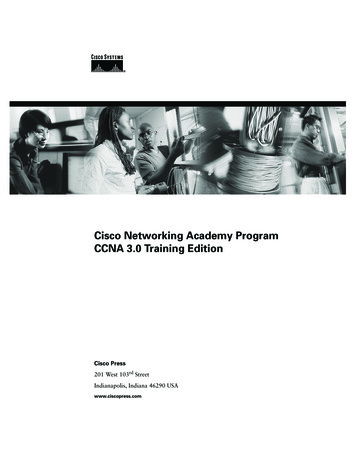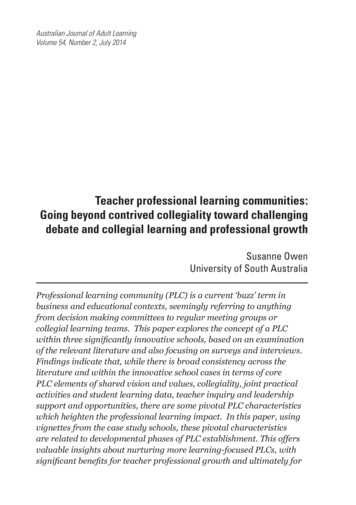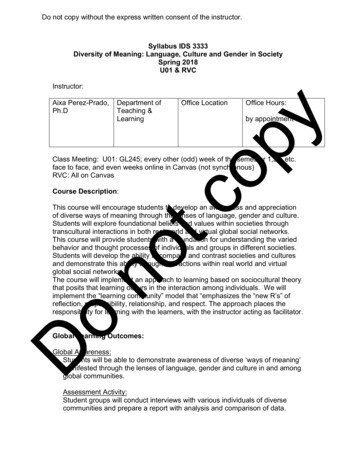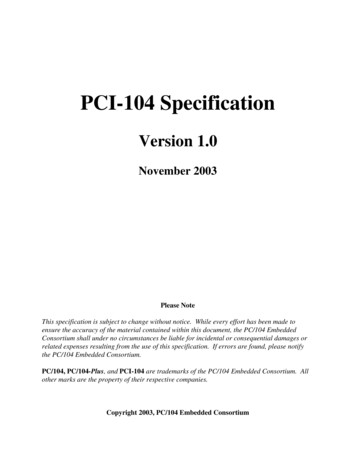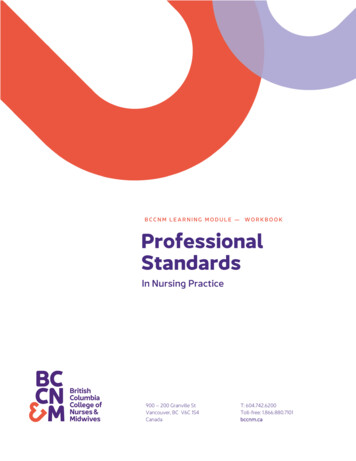
Transcription
BCCNM LEARNING MODULE — WORKBOOKProfessionalStandardsIn Nursing Practice900 – 200 Granville StVancouver, BC V6C 1S4CanadaT: 604.742.6200Toll-free: 1.866.880.7101bccnm.ca
IntroductionThis workbook offers activities that allow you to apply ideas presented in theon-line Learning Module. It is organized in four sections. Part 1 includes Workbook Activities that are related to various topic areasaddressed in the Learning Module. As you work through the module, you willbe directed to complete a specific Workbook Activity. Part 1 also includes pagesfor you to record your thoughts related to learning in this module. There aretwo pages: “Thoughts from Reflection Points” provides a space to jot downyour thoughts related to “Reflection Points” included in the Module, while“Insights and affirmations” provides a space to note new insights related to yourapplication of the Professional Standards in your practice. This information willbe useful for you in completing your ongoing Professional Development Plan atthe completion of this module. Part 2, “Applying My Learning”, includes case scenarios and associatedquestions. Completing the questions related to the cases provides anopportunity for you to apply information that has been offered in the modulein the context of practice-based scenarios. When you have completed thequestions, you may wish to compare your responses with those provided in the“Workbook Activities and Case Perspectives” located in Part 4. Part 3: This section of the workbook provides an opportunity for you tocreate a plan for your continued professional growth. A sample ProfessionalDevelopment Plan is provided to help you in this process. Part 4 presents sample responses to Workbook Activities and the case scenariosincluded in Part 2: “Applying My Learning.”professional standards in nursing practice workbookpage 2
1Workbook Activity #1 - Part 1Part 1 of this activity provides an opportunity for you to build familiarity with the Professional Standardsdocument. You will use information included in specific sections of the document to answer questions related toyour nursing practice.Please read: BCCNM Professional Standards for Registered Nurses and Nurse Practitioners. pp 1-6.https://www.bccnm.ca/Documents/standards practice/rn/RN NP Professional Standards.pdf1. Using the information included in the Professional Standards and the module discussion, please complete thefollowing sentences in your own words: The professional standards describe The indicators describe Because I am a self-regulating professional I 2. Indicate if the following statements are true or false: Indicators are listed in order of priority.TrueFalse The list of indicators for each area of practice includeevery action that a nurse might do in order to meet the standard.TrueFalse A nurse who usually works in education but sometimes assumesadministrative responsibility may find administrative indicatorshelpful in understanding the requirements of the administration role.TrueFalse A standard is an achievable level of nursing practice performance.TrueFalse Professional standards help the public understand theexpectations for professional nursing practice.TrueFalse The standards do not apply to nurses who do research.TrueFalse The standards provide a framework for professionaldevelopment activities.TrueFalseprofessional standards in nursing practice workbookpage 3
1Workbook Activity #1 - Part 1(continued)3. Beyond their over-riding role of offering direction and support for nurses in providing safe, competent andethical care for clients, how else could you or do you use the Professional Standards in your nursing practice?4. Imagine for a moment that you were in the following roles: How might you ‘use’ the Professional Standards if you were an employer of nurses? as a member of the public?professional standards in nursing practice workbookpage 4
1Workbook Activity #1 - Part 2Please review each of the following scenarios, consider the question posed at the end of each and note yourthoughts. It is OK to keep your responses brief at this time as you will have an opportunity to return to thesescenarios and add to your thoughts later in the module.Jordan has been a nurse for 5 years and works on a busy medical floor. A skiing accident a year ago left herwith chronic pain that got much worse when she worked. Frustrated that her prescribed medication was notalleviating her pain, she began using various ‘street’ drugs, telling herself ‘it was just an “extra” to help controlher pain so that she could work’. Initially she restricted her use of street drugs to her days off, but lately shehas begun consuming them on a regular basis. After conversations initiated by a close friend, Jordan hasnow realized she is addicted to the drugs and that this could negatively impact her ability to provide safeclient care. She knows that she wants to be healthy, so she removes herself from practice and contacts herphysician to ask for medical assistance. She also calls BCCNM to tell them that she has health issues thathave implications for her fitness to practice and asks for guidance about what she should do.Is this acceptable nursing practice?Celeste has been an RN for six months. Although she is glad to have graduated and be working as an RN, shemisses her ‘student life’ and being with her friends all day. She feels so ‘out of the loop’ on what’s happeningand has been using social media to stay in touch. She and her friends have developed a habit of updatingtheir Facebook status during and after a workday with humorous comments of the ‘low and ‘high’ lights oftheir workday. They are careful not to use names but often refer to situations involving interactions withclients or families.Is this acceptable nursing practice?professional standards in nursing practice workbookpage 5
1Workbook Activity #1 - Part 2(continued)Helen has recently started her first position as an educator on a busy surgical floor in a communityhospital. She is surprised to discover that some of the dressing procedures are not consistent with what sheunderstands to be best practices. When she raises this concern with the Nursing Unit Manager, the managersays, ‘This is the way we’ve always done it. It seems to work fine so I don’t really see what the issue is”. Helen isconcerned about ‘creating waves’ in her new job and so she decides to leave things ‘as-is’ at the moment andrevisit the concern ‘later’?What is acceptable nursing practice in this situation?David has recently begun a new role as unit manager. He is surprised to find that there is not a ‘standardizedtool’ for him to use for staff performance appraisal. Over the next few months, he works with a group ofadministrators in the health care agency to research relevant literature, review existing tools being usedin other disciplines, and talk to nurses about what they would like to see in a performance appraisal tool.Together, they design and develop a performance appraisal tool that reflects the Professional Standards. Asa final phase of development, David agrees to pilot its use with the staff of his nursing team, evaluate itseffectiveness and share the information with other administrators.Do David’s actions reflect acceptable nursing practice?professional standards in nursing practice workbookpage 6
2Workbook Activity #2Part 1This activity provides an opportunity for you to review the Standard 1 indicators for your area of nursingpractice and consider how they direct, support and/or are evident in your nursing practice.1. Begin by selecting a 2-3 hour section of an ‘average’ workday2. With this example of your nursing practice in mind, review the Standard 1 Indicators for your area of practice.For each indicator, note down an example of how that indicator is evident in your practice, or supports ordirects your practice.3. When you have completed your reflective review, ‘step back’ and consider your conclusions. What affirmationsand insights do these offer you with respect to your nursing practice? Are there areas where you are particularlystrong? Or perhaps indicators in which you are challenged to find strong evidence of how they appear in yourpractice?4. Next, consider any aspects of your nursing practice that you find challenging. With these in mind, re-readStandard 1 indicators. Do the indicators offer direction or support for you with respect to any of the challengesyou have identified?5. Before you return to the module, take a moment to record your insights and conclusions related to this activityon the “Affirmations and Insights” page of this Workbook. At the completion of the module, you will have anopportunity to use the insights and affirmations gained in various learning activities as part of your planning forfuture professional growth and development.Part 2Please return to the scenarios included with Workbook Activity # 1 . Re-read these and, using yourunderstanding of Standard 1: Professional Responsibility and Accountability, add to or refine your previousresponses to the questions with each example.professional standards in nursing practice workbookpage 7
3Workbook Activity #3Part 1This activity provides an opportunity for you to review Standard 2 indicators related to your area of nursingpractice and to consider the direction and support they provide for your nursing practice.1. Begin by reviewing Standard 2 indicators for your area of nursing practice. From there you can choose oneof two processes: Either repeat the process you used in the previous Workbook Activity – select a 2-3 hour section of arecent day at work. Then, with that example of practice in mind, return to the indicators and find anexample of how each one is evident in your practice, or directs or supports your practice. OR: Take a Standard to work with you – literally! Print out the indicators for your area of practice andcarry them with you in your work day. At regular intervals review the nursing care you have providedand then identify relevant indicators. Your goal in this process is to gain a sense of how these specificindicators direct and support your nursing practice.2. When you have completed Step 1, take some time to consider your conclusions. Are there areas where youhave strong evidence of meeting the Standard in your practice? Were there indicators in which you arechallenged to find strong evidence of how they appear in your practice? What insights and affirmations hasthis process offered you with respect to your nursing practice?4. Next, consider your nursing practice in general, and identify any aspects that you often find challenging.With these in mind, re-read the Standard 2 indicators. Do the indicators offer direction or support for youwith respect to any of the challenges you have identified?5. Before you return to the module, take a moment to record your insights and conclusions related to thisactivity on the “Affirmations and Insights” page of this Workbook. At the completion of the module, youwill have an opportunity to use the insights and affirmations gained in various learning activities, as part ofyour planning for future professional growth and development.Part 2Please return to the scenarios included with Workbook Activity # 1. Re-read these and, using yourunderstanding of Standard 2: Knowledge-Based Practice, add to or refine your previous responses to thequestions with each example.professional standards in nursing practice workbookpage 8
4Workbook Activity #4Part 1This activity provides an opportunity for you to review Standard 3 indicators for your area of nursingpractice and consider how they direct, support and/or are evident in your nursing practice.1. Begin by reviewing the Standard 3 indicators for your area of nursing practice. From there you can chooseone of the following three processes (the first two will be familiar to you): Select a 2-3 hour section of a recent day at work. And then, with that example of practice in mind,return to the indicators and find an example of how each one is evident in your practice, or directs orsupports your practice. Take a Standard to work with you – literally! Print out the indicators for your area of practice andcarry them with you in your work day. At regular intervals review the nursing care you have providedand then identify relevant indicators. Your goal in this process is to gain a sense of how these specificindicators direct and support your nursing practice. Pair up with a colleague who works in the same area of nursing practice as you. Ask him or her to sharea ‘typical example’ of their nursing practice. With that example in mind, return to the indicators andfind an example of how each one is evident in their practice, or directs or supports their practice. Now,repeat the process with you sharing your example with them. Compare your conclusions.2. When you have completed Step 1, take some time to consider your conclusions. If you completed either of the first two options, are there areas where you have strong evidence ofmeeting the Standard in your practice? Were there indicators in which you are challenged to findstrong evidence of how they appear in your practice? What insights and affirmations has this processoffered you with respect to your nursing practice? If you completed the third option, what similarities and differences did you notice between evidence ofthe indicators in yours and your colleague’s nursing practice? What insights and affirmations has thisprocess offered you with respect to your nursing practice?3. Before you return to the module, take a moment to record your insights and conclusions related to thisactivity on the “Affirmations and Insights” page of this Workbook.Part 2Please return to the scenarios included with Workbook Activity # 1. Re-read these and, using yourunderstanding of Standard 3: Client-Focused Provision of Service, add to or refine your previousresponses to the questions with each example.professional standards in nursing practice workbookpage 9
5Workbook Activity #5:Part 1This activity provides an opportunity for you to review Standard 4 indicators for your area of nursingpractice and consider how they direct, support and/or are evident in your nursing practice.1. Begin by reviewing Standard 4 indicators for your area of nursing practice. From there you can chooseone of the following four processes (the first three will be familiar to you): Select a 2-3 hour section of a recent day at work. And then, with that example of practice in mind,return to the indicators and find an example of how each one is evident in your practice, or directs orsupports your practice. Take a Standard to work with you – literally! Print out the indicators for your area of practice andcarry them with you in your workday. At regular intervals review the nursing care you have providedand then identify relevant indicators. Your goal in this process is to gain a sense of how these specificindicators direct and support your nursing practice. Pair up with a colleague who works in the same area of nursing practice as you (i.e. if you are aneducator, talk with another educator). Ask him or her to share a ‘typical example’ of their nursingpractice. Then, with that example in mind, return to the indicators and find an example of how eachone is evident in their practice, or directs or supports their practice. Now, repeat the process with yousharing your example with them. Compare your conclusions. Talk with a mentor about how each of the Standard 4 indicators direct and support their nursingpractice. Compare their experience with your own.2. When you have completed Step 1, take some time to consider your conclusions. If you completed either of the first two options, are there areas where you have strong evidence ofmeeting the Standard in your practice? Were there indicators in which you are challenged to findstrong evidence of how they appear in your practice? What insights and affirmations has this processoffered you with respect to your nursing practice? If you completed the third or fourth option, what similarities and differences did you notice betweenevidence of the indicators in your nursing practice and your colleague or mentor’s nursing practice?What insights and affirmations has this process offered you with respect to your nursing practice?professional standards in nursing practice workbookpage 10
5Workbook Activity #5:(continue)3. Next, return to the aspects of your nursing practice in general that you have previously identified aschallenging. With these in mind, re-read the Standard 4 indicators. Do the indicators offer direction orsupport for you with respect to any of the challenges you have identified?4. Before you return to the module, take a moment to record your insights and conclusions related to thisactivity on the “Affirmations and Insights” page located of this Workbook. At the completion of themodule, you will have an opportunity to use the insights and affirmations gained in various learningactivities, as part of your planning for future professional growth and development.Part 2Please return to the scenarios included with Workbook Activity # 1. Re-read these and, using yourunderstanding of Standard 4: Ethical Practice, add to or refine your previous responses to the questionswith each example.When you have completed Part 2 of this activity, you may wish to compare your thoughts related toeach of these scenarios with those provided in Part Four of this module, “Workbook Activities and CasePerspectives”. If you have any questions about the scenarios or would like to discuss any of these issuesfurther, please feel free to contact BCCNM Practice Support services. In addition, the LearningResources section of the module offers some additional relevant resources. These are listed in theResources under “Workbook Activity scenarios”.professional standards in nursing practice workbookpage 11
6Workbook Activity #6This final learning activity will guide you in developing a plan for future development in yournursing practice using the insights and information you have gained while completing this module.Please see Part #, “Growth Planning” in the Workbook for a plan outline and an example.1. Begin by reviewing the thoughts you have compiled on the “Affirmations and Insights” page. Theseinclude the conclusions you have formed about your understanding of the Professional Standards,and the direction and support they provide for your nursing practice.Take some time to read through these conclusions. First, notice and acknowledge your strengths andthe areas of your nursing practice that have been affirmed in the various activities. Then payattention to the areas that you have identified as areas for development and growth or perhaps areasthat represent ongoing challenges. As you read these, notice which ones seem to resonate with you orfeel most important to you. Use these conclusions to determine goals that will support your ongoinggrowth and professional development.2. Create three goals that reflect your focus for development in your nursing practice. Now write thesegoals on the planning page provided in Part # 3 of the Workbook, “Growth Planning”.3. The next step is to develop an action plan that will help you meet those goals. Begin by identifyingresources that you could use to assist you in meeting your goals. If you are not aware of specificresources, then begin by listing the sources you will explore in order to learn what you can do to supportyour growth toward your goals.4. Once you are familiar with the learning opportunities that are available to you, create an action planthat outlines specific strategies you will use, what resources you need in order to implement thesestrategies (e.g. who do you need to talk to, learning materials you want to acquire, learning experiencesyou need to arrange) and, importantly, include a target date for completion.Not sure how to do identify goals and create an action plan? Part # 3 of the Workbook, “GrowthPlanning” also includes a brief example. As well, it is recommended that you use the BCCNM QualityAssurance documents and resources to assist you in this process. If you wish to review these now,then access the link below.RN: https://www.bccnm.ca/RN/QA/Pages/Default.aspxNP: https://www.bccnm.ca/NP/QA/Pages/Default.aspx5. Finally: Add your plan to your ongoing Professional Development file or portfolio. And remember toupdate it once you have completed the actions!professional standards in nursing practice workbookpage 12
Notes from Reflection Pointsprofessional standards in nursing practice workbookpage 13
Professional Standards inNursing Practice:Affirmations and Insightsprofessional standards in nursing practice workbookpage 14
Part 2Applying My Learningprofessional standards in nursing practice workbookpage 15
1Case Scenario #1:Jackie and a Public HealthNursing TeamDuring a staff meeting in a Public Health Unit, several public health nurses reported a risingincidence of bullying in the local schools. The nurses described hearing stories from studentsattending the school health clinics about being bullied by fellow students and, in some cases,physically assaulted. As Jackie listened to the nurses’ stories she recognized that this was a seriousissue and decided to devote time and resources to investigating it and intervene as required.Jackie and the Public Health Nurse team spent time discussing how best to respond to this situationand came up with a plan for a three-phase response. In the first phase, they focused on gatheringinformation to help them understand the extent of the issue. They summarized statistics fromexisting documentation of school clinical visits and conducted information-gathering meetingswith other Public Health Nurses, as well as the school psychologist, and school, student, and parentrepresentatives. To help them understand the full implications of the facts they were gathering, theyalso reviewed relevant legislation, current literature related to bullying in schools, and BCCNMProfessional Standards, as well as Health Authority and School District policies related to schoolclinics, and school anti-bullying policies.The information gathered in this first phase, confirmed Jackie’s earlier decision to devote time andresources to this issue and so they continued with the second phase – the part of the planthat focused on education and provision of resources and support for all concerned. During Phase2, Jackie and selected Public Health Nurses continued to meet with and listen to school, parent,and student representatives in an effort to establish and align Public Health Nursing policiesand activities with school and family anti-bullying strategies. They also provided education andresources for Public Health Nurses related to anti-bullying policies and strategies.Finally, Jackie and the nurses worked with stakeholders to plan how they would evaluate theeffectiveness of their planned strategies and approaches. This third phase would gather perspectivesfrom students, school, and parents, as well as Public Health Nurses. This evaluation process woulddetermine if needs and expectations of each group of been met and also assess what informationand learning could be shared with other Public Health Units and Schools.professional standards in nursing practice workbookpage 16
1Case Scenario #1:Jackie and a Public HealthNursing TeamActivityPlease answer the following questions. When you have completed this activity, you may wishto compare your responses with those provided in the “Perspectives” section at the end of thisWorkbook.Using the Professional Standards to guide you: Identify relevant Standards that provide direction and support for the nurse(s) in the scenario. Forexample, does this scenario relate to Professional Responsibility and Accountability, KnowledgeBased practice, Client-Focused Provision of Service or Ethical Practice? There may be more than onestandard that will be relevant to this situation. Note these here. For each Standard you have identified as relevant, consider the indicators that relate to therole(s) of the nurse(s) in the example (e.g. clinical practice, administrative, education, or researchindicators). What direction do the indicators provide for the nurse(s) in this scenario? Recordyour thoughts here.professional standards in nursing practice workbookpage 17
1Case Scenario #1:Jackie and a Public HealthNursing Team (continue) If you have not already done so, consider the situation from the perspective of a nurse who worksin a different area of practice from the one you chose in the previous point. For example, ifyou focused on clinical practice indicators in the previous step, then review the indicators foradministration or education this time. Does this alternative point of view offer any new insights? Add your new thoughts to yourprevious notes.professional standards in nursing practice workbookpage 18
2Case Scenario #2:Tom and a Client ExperiencingMultiple TraumaIn the two years Tom had been working in this rural hospital, most clients experiencing severe multitrauma had been stabilized in their small emergency room and transported to a tertiary health careagency. This time, however, that was not the case. Josef, the client, had experienced thoracic trauma,complex fractures in his pelvis and both legs, and extensive soft tissue injuries in a heavy equipmentaccident. A severe winter storm meant that the rural hospital staff would need to provide care for Josefuntil weather improved enough for an air ambulance to operate.Tom’s experience with providing care for clients with severe multi-trauma was minimal, and he had beenvery aware of that when he found that Josef was assigned to his care. The one other RN on the shift withhim had an equally challenging workload and Tom realized he would need to do his best with Josef. Afterreviewing Josef ’s chart, Tom went to his room to get a better sense of his condition.Tom introduced himself to Josef and two family members who were also present and explained thathe needed to complete an assessment. After completing his assessment and determining that Josef wasstable and did not need any pain relief medication at that time, Tom returned to the nursing station todocument his assessment. Josef ’s sister followed Tom out of the room and asked him several questionsabout Josef ’s condition and prognosis. Tom was not able to answer all of her questions but promised herthat he would get more information and get back to her.After he had documented the assessment, Tom considered his need for more information related to Josef ’scondition and associated nursing care. As well as wanting to be able to answer Josef ’s sister’s questions,Tom had some questions of his own about specific assessment and care related to Josef ’s injuries. First, hedecided he would ask the ER physician to meet with Josef ’s family when he was available. He felt that wasan efficient way to provide an answer for most, if not all, of their questions. He would make sure he waspresent at the meeting so that he could follow up with Josef ’s family as required.To address his own needs for information, Tom planned three actions. First, he would look on the hospitalintranet, and see what he could find related to caring for multi-trauma clients. Second, when the otherRN on shift with him that day had completed her initial assessments, he would also talk with her. Third,Tom decided to call the Trauma Nurse Educator at the Tertiary Health Care agency where they typicallytransferred their clients.Tom’s intranet search and the conversation with the other RN yielded some information, but he still hadquestions. So, as planned, he phoned the Trauma Nurse Educator and explained the situation to her,using information from the recent assessment to provide a clear ‘picture’ of Josef ’s condition. She askedTom some questions regarding his previous experience with caring for multi-trauma clients, about whatother health care team members were working that day with Tom, and about Josef ’s current condition.Tom answered her questions and then listened carefully as she offered him specific information related toproviding care for Josef. She also told Tom she would fax him some current literature that would help himin caring for Josef and answering Josef ’s family’s questions. Finally, she asked Tom to summarize the keypoints of the information she had given him. Once she was sure he had understood her advice, she alsotold him to call her again if he needed any further assistance.After Tom had finished the phone call with the Clinical Educator, he documented the event in the nursingnotes and updated the Care Kardex to reflect the information she had offered.professional standards in nursing practice workbookpage 19
2Case Scenario #2:Tom and a Client ExperiencingMultiple TraumaActivityPlease answer the following questions. When you have completed this activity, you may wish to compareyour responses with those provided in the “Perspectives” section at the end of this Workbook.Using the Professional Standards to guide you: Identify relevant Standards that provide direction and support for the nurse(s) in the scenario. Forexample, does this scenario relate to Professional Responsibility and Accountability, Knowledge-Basedpractice, Client-Focused Provision of Service or Ethical Practice? There may be more than one standardthat will be relevant to this situation. Note these here. For each Standard you have identified as relevant, consider the indicators that relate to the role(s) of thenurse(s) in the example (e.g. clinical practice, administrative, education, or research indicators). Whatdirection do the indicators provide for the nurse(s) in this scenario? Record your thoughts here.professional standards in nursing practice workbookpage 20
2Case Scenario #2:Tom and a Client Exper
future professional growth and development. Part 2 Please return to the scenarios included with Workbook Activity # 1 . Re-read these and, using your understanding of Standard 1: Professional Responsibility and Accountability, add to or refine yo




